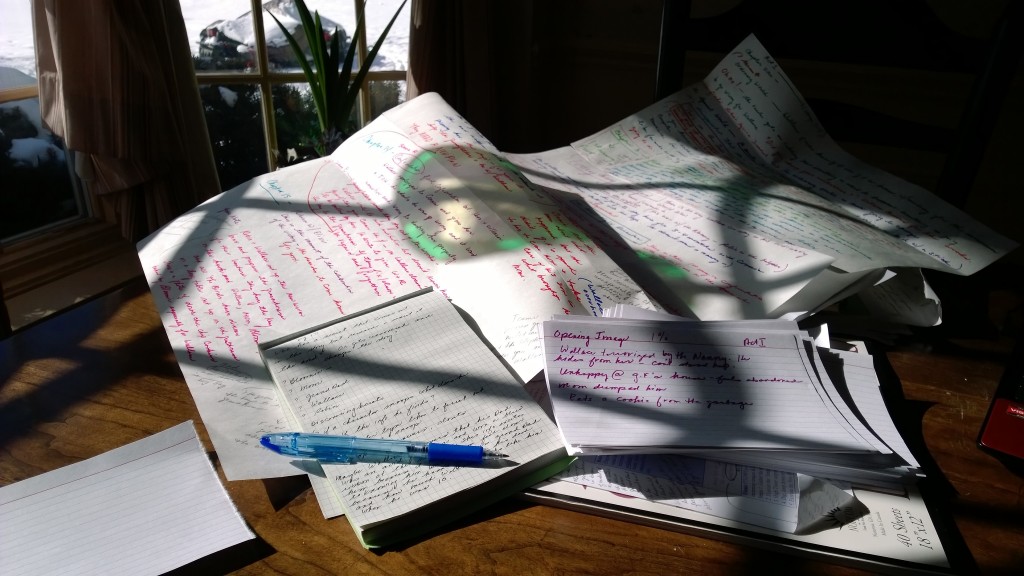There are a lot of blogs and resources out there telling ‘would be’ writers (or, as I call them, writers) how to write. I don’t want to do that, because I think it is different for all of us, and each writer needs to find out through experimentation and practice what works for them. But I am happy to share how I write.
The creative process for me isn’t a set method or system. Words come to me in many ways, starting with what I call a snippet – a scene, a character, a conversation, a fraction of dialogue, a moment between characters, a look, a confrontation – sometimes a few concrete ideas or story lines, and at the other end of the spectrum, a dream (sometimes a daydream, sometimes a night time epic adventure) featuring a fully formed story complete with character arcs, plot and climax, the entire epic drama, fresh to me upon waking, requiring only a keyboard and time to translate it onto a page.
Okay, admittedly, that has only really happened once. And it was amazing.
I wrote down as much of it as I could the morning after, certain the rest would stay solid in my memory. The clarity of the characters, their journey, the whole saga was so vivid and clear… It didn’t. What I wrote down that morning is all I have of that story. When I read my notes, I can still remember the dream. But it does seem like a lot more work to progress it beyond notes into a draft manuscript than I thought it would be that morning when I woke up with it. It is ‘shelved’. That’s what I call it when I have works in progress that I have set aside to ‘rest’. It happens more than you might think. For every book I finish, I have a handful more that got lost somewhere in the process. I like to think of them as stories not yet ready to be told, rather than failed manuscripts.
The reality is, a fully formed story is not the way it usually comes to me.
Most often it is a snippet. An intense conversation in my head about a random something, between some random people. I write it down. I write what they say, what they look like, where they are, why they are talking about this thing, and I gradually get a sense of who they are and what story they belong to. The story most often comes last. The people in it, always first.
Occasionally there is more of an idea for a story: I was sitting on a ski lift once, riding to the top of a mountain, feeling the weight of my snowboard dangling from my feet, feeling the cold on my cheeks, and I thought, I want to write a book about a girl who rides a snowboard for a living, following winter around the world and competing in competitions as a career. So I did.
Sometimes there is a what if…? What happens to everyone at the end of Damaged Goods? was a question I asked myself… and answered by writing companion novels from other characters’ points of view.
What I never do though, is write what I think you will want to read.
Okay, that sounds weird. Of course I want you to read what I write. Yes, I am writing and publishing because I want my stories to have an audience, and I want to have a readership. Of course I do!
But I remember an editor wanting me to change a character once. At first I was affronted, and felt defensive about the criticism. I tried to step back, consider their point of view, harden up and take the advice on board for what it was. Eventually I wrote pages and pages of justification and rationale for keeping the character the way she was in my head, knowing I didn’t want to change her, but thinking I would have to battle to “save” her. In the end though, the editor’s response was, “Okay!” The fact that I knew why the character I created was the way she was and I felt strongly enough about her to protect her the way I had written her, to not change her to make her more appealing or likeable, that I wanted to keep her real to me with all her glorious contradictions and imperfections, was enough to satisfy the editor. After all, perfection isn’t real; there is no such thing. I try not to write expectations. I write characters the way they are in my head, the way I imagine they would be in life. It’s the only way I know to keep it real. Keep them real. Keep me real.
I don’t have process for plot, or a process for planning. I am much more a pantster than I am a plotter. I almost always start with the characters, and let them take me where they need to go. As I have said before, sometimes it’s really hard work. But usually I just feel like a puppet on with my fingers on the keyboard.

